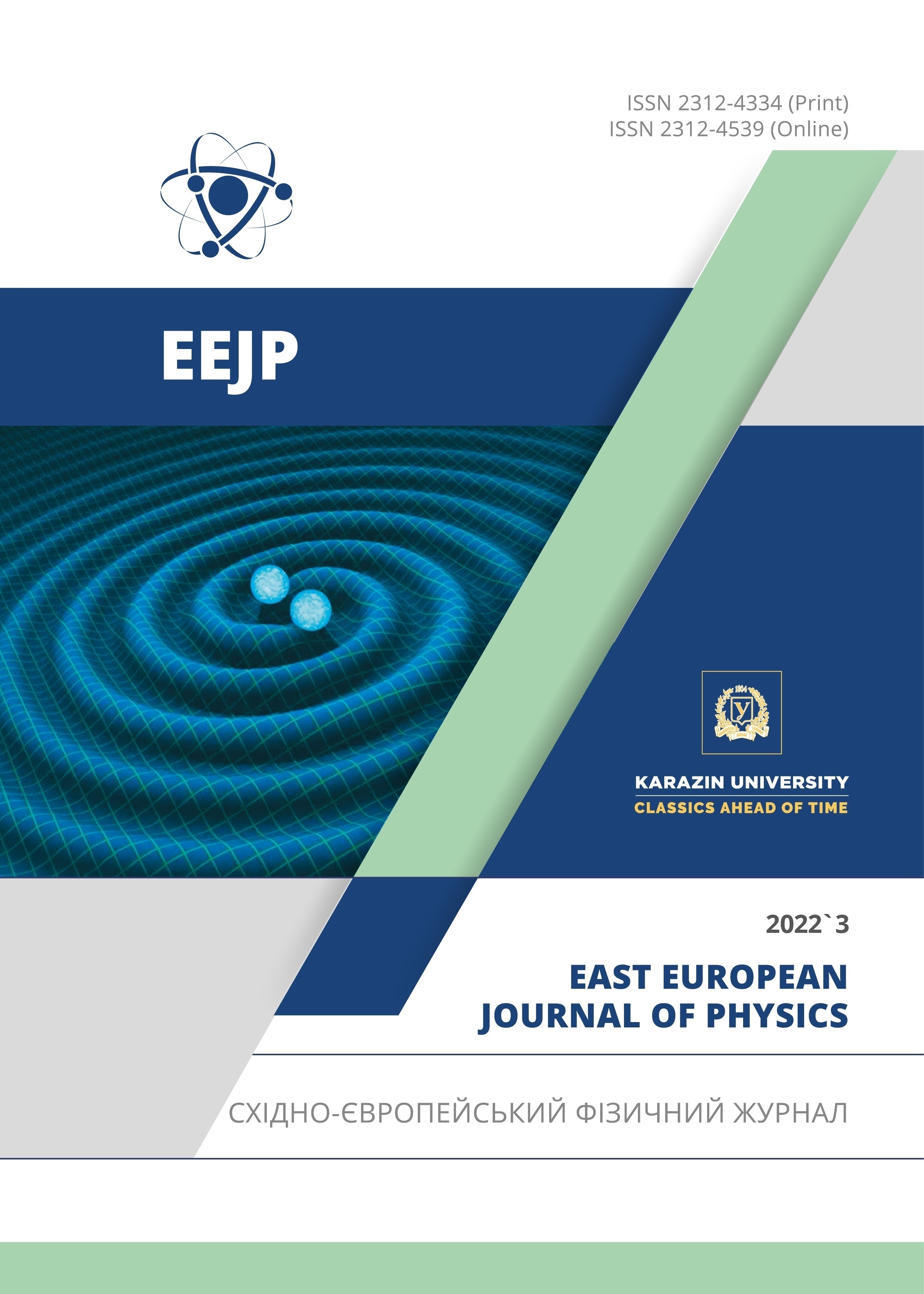Вплив гравітаційного поля на топологічний дефект на статистичні властивості важких кварк-антикваркових систем
Анотація
У цій статті ми визначаємо власні енергії, власні функції та статистичні властивості нерелятивістського важкого кварконію, що взаємодіє з розширеним потенціалом Корнеля в просторі-часі, створеному космічною струною. Ми розширюємо потенціал Корнеля, додаючи обернений квадратний потенціал плюс квадратичний потенціал. Ми розрахували власні значення енергії та відповідні власні стани за допомогою розширеного методу Нікіфорова-Уварова (ENU). Потім на основі рівняння енергетичних спектрів обчислюються термодинамічні властивості, такі як статистична сума, ентропія, вільна енергія, середня енергія та питома теплоємність у просторі-часі космічної струни. На наступному кроці ми досліджуємо вплив параметра космічної струни на квантові стани важких кварконіїв та їх статистичні властивості.
Завантаження
Посилання
L.R. Ribeiro et al, Phys. Lett. A, 348, 135 (2006). https://doi.org/10.1016/j.physleta.2005.08.046
K. Bakke, Int. J. Mod. Phys. A, 26, 4239 (2011). https://doi.org/10.1142/S0217751X11054437
Y. Aharonov, and D. Bohm, Phys. Rev. 115, 485 (1959). https://doi.org/10.1103/PhysRev.115.485
K.W.B. Kibble, J. Phys. A: Math. Gen. 9(8), 1387 (1976). https://doi.org/10.1088/0305-4470/9/8/029
K.W.B. Kibble, Phys. Rev. D, 26(2), 435 (1982). https://doi.org/10.1103/PhysRevD.26.435
A. Vilenkin, and E.P.S. Shellard, Cosmic Strings and Other Topological Defects, (Cambridge University Press, Cambridge, U.K., 1994).
J. Rocher, Thèse de Doctorat, Contraintes cosmologiques sur la physique de l'univers primordial, Universit de Paris XI-Orsay, 2005.
L. Bergström, and A. Goobar, Cosmology and Particle Astrophysics, 2nd edition (Springer, 2006).
A.-C. Davis, and T.W. Kibble, Contemp. Phys. 46, 313 (2005). https://doi.org/10.1080/00107510500165204
N.G. Marchuk, Nuovo. Cimento. B, 115, 11 (2000). https://doi.org/10.48550/arXiv.math-ph/0010045
C. Furtado, V.B. Bezerrae, and F. Moraes, Phys. Lett. A, 289, 160 (2001). https://doi.org/10.1016/S0375-9601(01)00615-6
C. Furtado, B.G.C. da Cunha, F. Moraes, E.R.B. Mello, and V.B. Bezzerra, Phys. Lett. A, 195, 90 (1994), https://doi.org/10.1016/0375-9601(94)90432-4
J. Audretsch, and A. Economou, Phys. Rev. D, 44, 3774 (1991). https://doi.org/10.1103/PhysRevD.44.3774
D.D. Harari, and V.D. Skarzhinsky, Phys. Lett. B, 240, 322 (1990). https://doi.org/10.1016/0370-2693(90)91106-L
J.R. Gott III, Astrophys. 288, 422 (1985). https://adsabs.harvard.edu/pdf/1985ApJ...288..422G
V.B. Bezerra, Phys. Rev. D, 35, 2031 (1987). https://doi.org/10.1103/PhysRevD.35.2031
W. Florkowski, Phenomenology of Ultra-Relativistic Heavy-Ion Collisions, (World Scientific Singapore, 2010), pp. 416.
U. Kalade, and B.K. Patra, Phys. Rev. C, 92, 024901 (2015). https://doi.org/10.1103/PhysRevC.92.024901
T. Matsui, and H. Satz, Phys. Lett. B, 178, 416 (1986). https://doi.org/10.1016/0370-2693(86)91404-8
R.C. Hwa, and X.N. Wang, editors, Quark-Gluon Plasma 3, (World Scientific Publishing, 2004), pp. 788.
V.S. Filinov, M. Bonitz, Y.B. Ivanov, M. Ilgenfritz, and V.E. Fortov, Contrib. Plasma Phys. 55, 203 (2015). https://doi.org/10.1002/ctpp.201400056
M. Schleif, and R. Wunsch, Eur. Phys. J. A, 1, 171 (1998). https://doi.org/10.1007/s100500050046
M. Abu-Shady, Inter. J. Theor. Phys. 52, 1165 (2013). https://doi.org/10.1007/s10773-012-1432-z
M. Abu-Shady, Inter. J. Theor. Phys. 54, 1530 (2015). https://doi.org/10.1007/s10773-014-2352-x
D. Nga Ongodo, J.M. Ema'a Ema'a, P. Ele Abiama, and G.H. Ben-Bolie, Int. J. Mod. Phys. E, 28, 1950106 (2019). https://doi.org/10.1142/S0218301319501064
Al-Jamel, Mod. Phys. Lett. A, 33, 1850185 (2018). https://doi.org/10.1142/S0217732318501857
H. Karayer, D. Demirhan, and F. Büyükilic, J. Math. Phys. 59, 053501 (2008). https://doi.org/10.1063/1.5022008
M.D. Katanaev, and I.V. Volovich, "Theory of defects in solids and three-dimensional gravity", Annals of Physics, 216(1), 1 1992. https://doi.org/10.1016/0003-4916(52)90040-7
C. Furtado, and F. Moraes, Phys. Lett. A, 188(4-6), 394 (1994). https://doi.org/10.1016/0375-9601(94)90482-0
C.R. Muniz, V.B. Bezerra and M.S. Cunha, Ann. Phys. 350, 105 (2014). https://doi.org/10.1016/j.aop.2014.07.017
V.F. Mukanov, H.A. Feldman, and R.H. Brandenberger, Physical Report 215, 203 (1992). https://doi.org/10.1016/0370-1573(92)90044-Z
J.L. Domenech-Garret, and M.A. Sanchis-Lozano, Physics Letters B, 669(1), 52 (2008). https://doi.org/10.1016/j.physletb.2008.09.021
Y. Cançelik, and B. Gönül, Mod. Phys. Lett. A, 29, 1450170 (2014). https://doi.org/10.1142/S0217732314501703
M. Modarres, and A. Mohamadnejad, Phys. Part. Nucl. Lett. 10, 99 (2013). https://doi.org/10.1134/S1547477113020106
M. Modarres, and H. Gholizade, Int. J. Mod. Phys. E, 17, 1335 (2008). https://doi.org/10.1142/S0218301308010453
A.N. Ikot, B.C. Lutfuoglu, M.I. Ngweke, M.E. Udoh, S. Zare, and H. Hassanabadi, Eur. Phys. J. Plus, 131, 419 (2016). https://doi.org/10.1140/epjp/i2016-16419-5
W.A. Yahua, and K.J. Oyewumi, J. Asso. Arab. Univ. Bas. App. Scie, 21, 53 (2016). https://doi.org/10.1016/j.jaubas.2015.04.001
H. Hassanabadi, and M. Hosseinpoura, Eur. Phys. J. C, 76, 553 (2016). https://doi.org/10.1140/epjc/s10052-016-4392-2
Авторське право (c) 2022 А.A.А. Лікене, А. Зарма, Д.Н. Онгодо, Ж.-М. Ема'а Ема'а, П.Е. Абіам, Ж.Ю. Бен-Боліє.

Цю роботу ліцензовано за Міжнародня ліцензія Creative Commons Attribution 4.0.
Автори, які публікуються у цьому журналі, погоджуються з наступними умовами:
- Автори залишають за собою право на авторство своєї роботи та передають журналу право першої публікації цієї роботи на умовах ліцензії Creative Commons Attribution License, котра дозволяє іншим особам вільно розповсюджувати опубліковану роботу з обов'язковим посиланням на авторів оригінальної роботи та першу публікацію роботи у цьому журналі.
- Автори мають право укладати самостійні додаткові угоди щодо неексклюзивного розповсюдження роботи у тому вигляді, в якому вона була опублікована цим журналом (наприклад, розміщувати роботу в електронному сховищі установи або публікувати у складі монографії), за умови збереження посилання на першу публікацію роботи у цьому журналі.
- Політика журналу дозволяє і заохочує розміщення авторами в мережі Інтернет (наприклад, у сховищах установ або на особистих веб-сайтах) рукопису роботи, як до подання цього рукопису до редакції, так і під час його редакційного опрацювання, оскільки це сприяє виникненню продуктивної наукової дискусії та позитивно позначається на оперативності та динаміці цитування опублікованої роботи (див. The Effect of Open Access).








